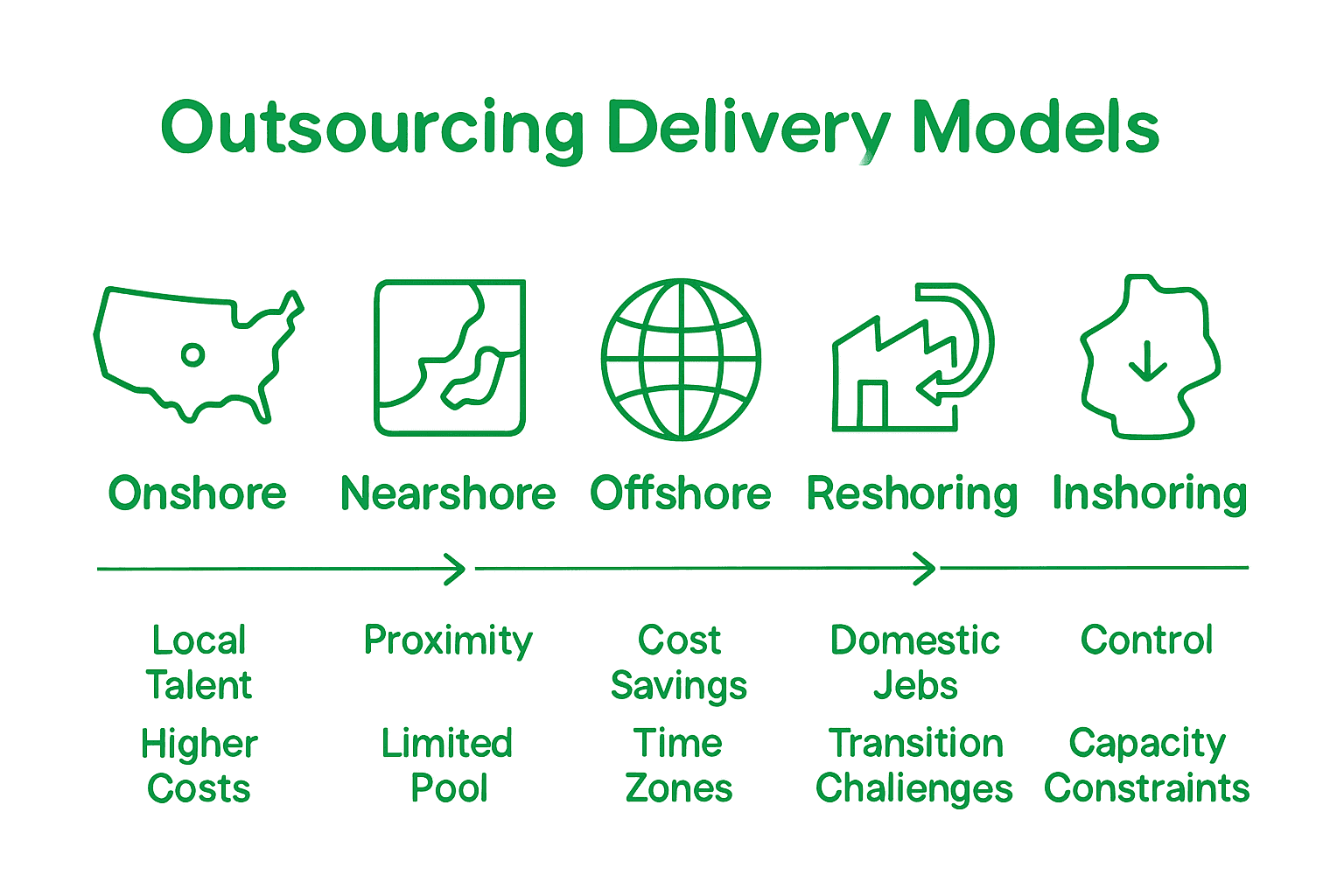Did you know that companies can cut operational costs by as much as 30 percent through strategic outsourcing? Business leaders face constant pressure to deliver more with fewer resources, making efficiency and access to specialized talent more valuable than ever. By understanding how outsourcing models work, organizations can make smarter decisions, streamline operations, and stay ahead in a fast-changing market.
Outsourcing business operations is a strategic approach where companies delegate specific tasks or entire business processes to external specialized providers. According to Wikipedia’s definition, outsourcing involves contracting internal functions to an external organization, which can include transferring employees or assets to optimize organizational performance.
At its core, outsourcing enables businesses to focus on their primary competencies while leveraging external expertise. Read more about why business owners outsource for growth to understand its strategic importance. The practice typically covers non-core tasks such as:
- Payroll processing
- Customer support services
- Data entry and management
- IT infrastructure maintenance
- Human resources administration
A specific form of outsourcing, Business Process Outsourcing (BPO), allows companies to delegate entire operational responsibilities to third-party providers. According to research, BPO delivers multiple strategic advantages:
- Enhanced operational flexibility
- Significant cost reduction
- Access to specialized skills
- Improved organizational focus on core business functions

By strategically outsourcing non-critical functions, organizations can streamline operations, reduce overhead expenses, and allocate resources more effectively toward innovation and growth initiatives.
Outsourcing delivery models represent diverse strategies businesses can leverage to optimize their operational efficiency. According to Wikipedia’s research on offshoring, organizations have multiple geographic approaches for delegating business processes, each with unique strategic implications.
Offshore Outsourcing involves relocating business processes to another country, typically targeting regions with lower operational costs. Learn more about IT outsourcing trends to understand how global strategies evolve. The primary geographic delivery models include:
- Onshore Outsourcing: Contracting services within the same country
- Nearshore Outsourcing: Engaging providers in neighboring or geographically close countries
- Offshore Outsourcing: Sourcing services from distant international locations
- Reshoring: Bringing previously outsourced operations back to the original country
- Inshoring: Utilizing domestic subsidiaries or internal departments for specialized services
Each delivery model offers distinct advantages depending on an organization’s specific requirements.
Companies must evaluate factors such as:
Here’s a comparison of common outsourcing delivery models:

| Delivery Model | Geographic Scope | Key Advantages | Considerations |
|---|---|---|---|
| Onshore Outsourcing | Same country | Easy communication Regulatory alignment | Higher costs |
| Nearshore Outsourcing | Neighboring/close countries | Shared time zone Cultural similarity | Limited talent pool |
| Offshore Outsourcing | Distant international locations | Cost savings Large talent pool | Time zone gaps Complex logistics |
| Reshoring | Returning to original country | Regained control Quality focus | Reintegration costs |
| Inshoring | Domestic subsidiaries/departments | Full oversight Internal expertise | Limited flexibility |
- Cost efficiency
- Talent accessibility
- Communication complexity
- Regulatory compliance
- Cultural alignment
Strategic outsourcing requires careful consideration of these models to ensure optimal operational performance, cost management, and seamless integration of external expertise into existing business processes.
Cost reduction remains the primary driver for businesses considering outsourcing strategies. Explore outsourced IT solutions to understand how companies optimize their technological investments. According to research from Keevee, organizations can achieve remarkable operational improvements through strategic outsourcing.
The quantifiable benefits are impressive:
- 30% reduction in operational costs
- 80% improvement in overall operational efficiency
- 25% faster process acceleration
- 20% reduced time-to-market for products and services
- 22% increase in customer satisfaction levels
Beyond financial advantages, outsourcing provides strategic benefits that transform organizational capabilities. Companies gain access to specialized talent pools, advanced technological infrastructure, and flexible workforce solutions without substantial internal investments. This approach allows businesses to:
- Focus on core competency development
- Scale operations rapidly
- Minimize recruitment and training expenses
- Access global talent without geographical limitations
- Implement cutting-edge technologies more efficiently
By strategically selecting external partners, organizations can create a lean, adaptable operational model that responds quickly to market changes while maintaining high-performance standards and competitive advantages.
Financial considerations play a critical role in determining the success of outsourcing strategies. Understanding the nuanced economic implications helps businesses make informed decisions about external resource allocation. Learn about why business owners choose to outsource to gain deeper insights into strategic financial planning.
Outsourcing involves several direct and indirect financial dimensions that organizations must carefully evaluate:
- Initial transition costs: Investment required to establish external partnerships
- Long-term operational expenses: Potential savings versus internal resource management
- Hidden implementation expenses: Technology integration, training, and communication infrastructure
- Risk mitigation investments: Cybersecurity, compliance, and quality assurance measures
- Performance monitoring overhead: Additional expenses for tracking external team productivity
Companies must conduct comprehensive financial analysis considering both tangible and intangible economic factors. This involves:
- Calculating total cost of ownership
- Comparing internal versus external resource expenses
- Projecting long-term financial implications
- Assessing potential return on investment
- Understanding potential tax and regulatory financial considerations
Successful financial management in outsourcing requires a holistic approach that balances immediate cost savings with strategic long-term value creation, ensuring that external partnerships contribute meaningfully to overall organizational financial health.
Vendor management represents a critical component of successful outsourcing strategies, requiring comprehensive risk assessment and legal framework development. Learn more about what is outsourced in IT to understand the complex landscape of external partnerships and potential vulnerabilities.
Modern organizations face multiple risk dimensions when engaging external providers:
- Operational risks: Potential disruptions in service delivery
- Compliance risks: Potential legal and regulatory violations
- Data security risks: Potential breaches of confidential information
- Quality control risks: Inconsistent performance standards
- Financial risks: Unexpected cost overruns or hidden expenses
According to emerging research from blockchain technology frameworks, innovative approaches are emerging to mitigate these risks. Cutting-edge solutions now enable:
- Real-time compliance monitoring
- Transparent vendor assessment processes
- Tamper-proof auditing mechanisms
- Enhanced security control implementations
- Comprehensive traceability of vendor interactions
Effective vendor management requires a strategic approach that combines rigorous initial screening, continuous performance evaluation, clear contractual frameworks, and adaptive risk mitigation strategies. Organizations must develop robust governance models that balance operational flexibility with stringent control mechanisms, ensuring external partnerships consistently align with core business objectives and maintain high standards of reliability and performance.
Unlock Seamless Growth With Strategic Outsourcing
Are you struggling to keep your internal teams focused while managing rising costs and operational complexity? The challenges outlined in the Complete Guide to Outsourcing Business Operations—like finding specialized talent, controlling expenses, and integrating external expertise—can block your path to growth. At NineArchs LLC, we turn these hurdles into stepping stones for your business success. Our tailored outsourcing solutions help you stay agile and competitive by providing access to a global workforce and streamlined processes. Embrace cost reduction, efficiency gains, and specialized skillsets by working with a trusted partner who values professionalism, scalability, and innovation.

Ready to elevate your operations and refocus on what matters most? Discover how NineArchs LLC empowers you to overcome outsourcing risks and cost challenges while keeping quality and compliance in check. Visit our site today for a personalized consultation and start building the remote team that will drive your next level of growth. Make your move now to experience smarter business process outsourcing and outsourced IT solutions designed for forward-thinking companies.
Frequently Asked Questions
What is outsourcing business operations?
Outsourcing business operations is the practice of delegating specific tasks or entire business processes to external specialized providers, allowing companies to focus on core competencies while leveraging external expertise.
What are the common types of tasks that companies outsource?
Companies typically outsource non-core tasks such as payroll processing, customer support services, data entry and management, IT infrastructure maintenance, and human resources administration.
What are the advantages of Business Process Outsourcing (BPO)?
BPO offers several advantages, including enhanced operational flexibility, significant cost reductions, access to specialized skills, and improved focus on core business functions, leading to better overall performance and efficiency.
How can businesses effectively manage vendor relationships in outsourcing?
Effective vendor management involves conducting rigorous initial screening, continuous performance evaluations, clear contractual frameworks, and adaptive risk mitigation strategies to ensure that external partnerships align with business objectives and maintain high operational standards.
Recommended
- Understanding Why Business Owners Outsource for Growth | NineArchs
- Understanding What is Outsourced IT for Businesses | NineArchs
- Understanding IT Outsourcing Trends in 2025 | NineArchs
- Business Process Outsourcing | NineArchs
- What Is Freight Forwarding? Guide for Modern Supply Chains 2025 – ORNER
- How to Import Goods: A Step-by-Step Guide for Success – Worldwide Express, Inc.










[…] businesses to completely offload complex, non-core functions while maintaining strategic oversight. Complete Guide to Outsourcing Business Operations provides deeper insights into implementing these comprehensive […]